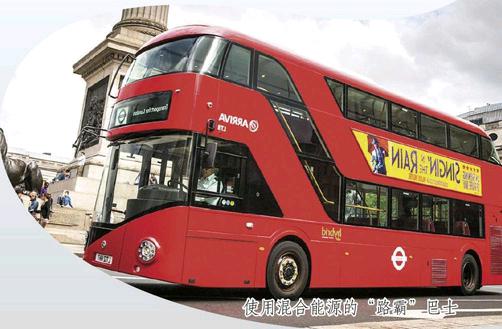伦敦:后雾都时代
By+Jon+Excell
浓雾茫茫,遮天蔽日,行人步履匆匆,咳声此起彼伏。这不是世界末日,也不是雾霾天的北京,而是1952年12月5日的伦敦。那场雾霾夺去了成千上万人的性命,英国政府痛下改革决心,在此后的数十年中一直致力于空气污染的整治。如今的伦敦已不复当年“雾都”的景象,却仍走在治理空气污染的路上。往者可鉴,来者可追。只要污染存在一日,人们探索的脚步就不会停歇。
Imagine smog so thick that you cant see your feet as you walk through it; so impenetrable that it blots out1) the sun; so toxic that it stings your eyes and leaves you gasping for breath.
It may sound like the backdrop2) to some post-apocalyptic nightmare, but on 5 December 1952, this terrifying scenario became the reality for the people of London. That days incident alone killed thousands and prompted a global transformation in the way we deal with air pollution.
On that cold, clear day in 1952, Londoners huddled around their coal fires for warmth. But while the smoke would normally disperse into the atmosphere, an anticyclone3) hanging over the region created an inversion—trapping the pollution close to the ground and leading to the formation of a sulphurous4), toxic shroud5) that would blanket the capital for the next five days.
Before the weather conditions changed and the smog retreated, thousands had died. Official estimates at the time put the number of fatalities at 4,000—more civilian casualties than were caused by any single incident during the war—while recent research suggests that it may have caused as many as 12,000 deaths.

“Necessary Evil”
“必要之恶”
Although “pea-soupers,” as the smogs were known, had been an unavoidable feature of Britains major cities for more than a hundred years, the Great Smog of 1952 was the worst.
It also marked something of a turning point: Until then, people had accepted smog as a necessary evil6). “In Britains coal-fuelled cities, smoke was tolerated for more than a century as a trade-off for jobs and home comforts,” says environmental historian Dr Stephen Mosley. Some even celebrated air pollution as a tangible measure of Britains industrial vitality, while the blazing7) coal fire, with all its cosy connotations of “home and hearth8),” was a luxury few were prepared to give up.
Despite growing public pressure to deal with the issue, the governments reaction was sluggish9). Initially it even claimed that Decembers high mortality was due to a flu outbreak, and seven months elapsed before it eventually ordered an inquiry.
Four years later, in 1956, the Clean Air Act came into force, banning the burning of polluting fuels in “smoke control areas” across the UK.
The act was truly revolutionary, representing a major global milestone in environmental protection. Public health was vastly improved; flora10) and fauna11) that had all but vanished from urban places by the 1950s began to flourish; and the grand architecture of Britains cities was no longer obscured beneath a thick layer of soot12) and grime13). In the years that followed, a host of other industrial nations were inspired to follow suit.
Air Issues
空气问题
But, while air pollution from coal may be a thing of the past, Londons air quality problem hasnt gone away. And with a recent study suggesting that pollution in the capital claims14) as many as 9,500 lives a year, a growing number of scientists, politicians and campaigners believe that on the eve of the Clean Air Acts 60th anniversary, the UK must once again invoke its pioneering spirit.
The study, which was carried out for Transport for London by Kings College Londons Environmental Research Group, attributes these premature deaths to two main pollutants: fine particulates known as PM2.5 and the toxic gas nitrogen dioxide (NO2).
NO2 levels are of particular concern. London has the worlds highest measured levels of the gas and has breached EU safety limits every year for the last five. In 2015, NO2 levels on Oxford Street broke the annual limit in just four days.
The KCL study estimated that the gas could be to blame for as many as 5,900 premature deaths a year.
While scientists have been aware of NO2s toxic properties for many years, the fact that its usually present with other pollutants has made it difficult to isolate its impact, says Kings College air quality specialist Martin Williams. Only now have researchers been able to conclude that there is an independent effect.
Nevertheless, says the studys author Dr Heather Walton, there is still some uncertainty on exactly how many deaths can be attributed to the gas.
NO2 pollution has a range of sources. But according to the governments Department for Environment and Rural Affairs, emissions from transport account for at least 80%. Diesel15) vehicles, which form more than a third of Londons road traffic, are the biggest culprits16).
Because of their fuel efficiency and lower CO2 emissions, diesel engines have been heavily incentivised17) over the last couple of decades—with successive governments turning a blind eye to their higher particulate and NOx emissions.
Ironically, the effect of diesel engines has been made worse by the use of technology designed to make them less polluting. “Diesels emit particles in much larger quantities than petrol cars so were fitted with particle filters,” says Williams. “These trap the particles on filters, but every now and again they have to be burned off—NOx in emissions is converted to NO2 which helps to oxidise and burn off particles in the filter. To solve the particle problem, NO2 emissions were being increased.”

Breathing Easier?
呼吸更轻松?
The good news is that NO2 levels are beginning to fall. Selective catalytic reduction systems, which are able to remove many of the NOx emissions from exhausts, are now legally required on many of the most polluting diesel vehicles, and the KCL study points to a modest decline in concentrations over the past few years.
Newer, less polluting vehicles are being rolled out across the capital. More than 1,200 hybrid buses now operate in London, including the new diesel-electric Routemaster18)—which according to TFL produces a quarter of the NOx and particulate emissions of conventional diesel buses. TFL is also expected to shortly announce the introduction of the worlds first zero-emissions double-decker19).
Efforts are also underway to clean up the citys taxi fleet, with TFL recently announcing that from January 2018, all new taxis licensed in London must emit less than 50g/km of CO2 and have a zero-emission range of 30 miles. Earlier this year Metrocab, a battery-powered vehicle that uses a small combustion engine20) as a range extender, became TFLs first licensed zero-emission-capable taxi. And the London Taxi Company recently unveiled the prototype TX5, a lightweight, battery-powered black cab that it plans to put into production during 2016.
There is also the much trumpeted21) Ultra Low Emission Zone: From 2020, all vehicles entering Londons existing congestion charge zone will need to meet exhaust emissions standards or pay an additional daily charge to travel.
But many claim these developments dont go far enough. The mayors office has faced heavy criticism for ditching its initial plans to simply ban the most polluting vehicles from the emission zone. Whats more, a recent survey of 500 businesses found that 23% would rather pay a charge than upgrade their vehicles.

Precedent for Change
改革先例
Others point to the far wider-reaching changes of the Clean Air Act as an example of how people can adapt. “Before the Clean Air Act, people said ‘the government doesnt have the money; the poor are going to starve or freeze. And that wasnt what happened,” says Simon Birkett, founder of campaigning group Clean Air in London. “Once these limits are put in place, people find the cheapest way of complying with them.”
Still, perhaps the main lesson to be learned from history is that it is exceptionally challenging to persuade people to change their habits—and to persuade government to force this change.
“The right to burn a coal fire in ones own home was seen as an inviolable22) freedom in the past, and not until the 1952 smog did the government feel that it had sufficient public support to make changes that affected personal liberty,” Mosley says. “Lets hope that it wont be a case of history repeating itself.”
试想一下,你走在浓浓的雾霾中,甚至看不见自己的脚;雾霾遮蔽天日,透不进阳光;雾霾毒性很强,让你眼睛酸痛,呼吸困难。
这听起来也许像是有关末世之后的一场噩梦中的场景,但是在1952年12月5日,这恐怖的一幕对伦敦居民来说成为现实。仅仅是那一天的雾霾事件就导致数千人死亡,这也促使全世界对待空气污染的态度开始发生转变。
1952年的那一天寒冷又晴朗,伦敦居民围在自家的煤火前取暖。但是烟雾没有像往常一样消散于大气中,笼罩在伦敦上空的高气压形成了反向运动,将污染物困在地表,形成了一层由硫化物构成的有毒覆盖物,在接下来的五天里笼罩整个首都。
等到天气状况改善,烟雾散去,数千人已经丧命。当时官方估计的死亡人数为4000人——比战时任何一次事件导致的平民伤亡人数都要多。不过,最近的研究显示,那次事件导致的死亡人数可能高达12000人。
虽然一百多年里,这种被称作“黄色浓雾”的雾霾一直都是英国各大城市无可避免的特征,但1952年的大雾却是最严重的。
这场雾霾在某种程度上也是一个转折点:在那之前,人们已接受了雾霾,将其看做是必要之恶。“一个多世纪以来,在英国烧煤的城市中,人们忍受烟雾,将其视为就业和家庭舒适的代价。”环境历史学家斯蒂芬·莫斯利博士说道。有些人甚至赞美空气污染,认为那是英国工业活力的有形体现,而煤块燃起的熊熊火焰带有“温暖的家”的温馨内涵,这种奢侈没几个人准备放弃。
尽管民众要求应对这一问题的呼声日益高涨,政府的反应却是一拖再拖。起初,政府甚至声称12月份的死亡人数之所以高是因为爆发了流感。又过了七个月,政府最终才下令调查。
四年之后的1956年,《空气洁净法案》开始实施,禁止在全英国的“烟雾控制区”燃烧会造成污染的燃料。
这项法案具有真正的革命性意义,是全世界环保事业一座重要的里程碑。公共健康得以大幅度改善;20世纪50年代在城市地区几乎绝迹的动植物又开始繁衍生长;英国城市里宏伟的建筑也摆脱了厚厚的煤烟和灰尘,得以展现真容。接下来的几年,其他许多工业国家也受到了启发,纷纷效仿。
空气问题
不过,燃煤造成的空气污染也许已是陈年往事了,但伦敦的空气质量问题还没有消除。最近的一项研究表明,伦敦的污染问题每年导致多达9500人死亡,越来越多的科学家、政坛人士和活动人士认为,在《空气洁净法案》诞生60周年前夕,英国必须再一次发扬敢为人先的精神。
该研究是由伦敦国王学院环境研究小组应伦敦交通局的需求完成的。研究将这些人的过早死亡主要归因于两种污染物:一种是叫做PM2.5的细微颗粒物,另一种是有毒气体二氧化氮。
二氧化氮浓度尤其令人担心。伦敦空气中测得的该气体的浓度是全球最高的,在过去五年中每年都突破了欧盟设定的安全限值。2015年,牛津街的二氧化氮水平仅仅在四天内就冲破了全年的限值。
据伦敦国王学院的研究估算,每年多达5900人因为二氧化氮而过早死亡。
国王学院的空气质量专家马丁·威廉姆斯称,虽然科学家们多年来都知道二氧化氮有毒性,但是由于该气体通常与其他污染物同时出现,科学家们很难单独测定其影响。直到现在研究人员才能得出结论,二氧化氮本身就对人体有影响。
然而,该研究报告的作者希瑟·沃尔顿博士称,到底有多少人的死因是二氧化氮,这一点仍然无法完全确定。
二氧化氮污染有很多源头,但是按照英国环境和农业部的说法,至少有80%的二氧化氮来自于交通工具排放的废气。占伦敦路面车辆三分之一以上的柴油车是罪魁祸首。
柴油机由于燃油效率较高,二氧化碳排放量又较低,因而在过去的几十年中得到了大力推广,连续几届政府都对其较高的颗粒污染物和氮氧化物排放视而不见。
讽刺的是,由于使用了为减轻污染而设计的技术,柴油机的污染反而更严重了。“柴油车比汽油车排放的颗粒物多得多,因此柴油车上装有颗粒物过滤器,”威廉姆斯说,“这些过滤器把颗粒物留在上面,但是颗粒物时不时要被烧掉——汽车排放的氮氧化物会转化为二氧化氮,后者有助于氧化并燃烧过滤器中的颗粒物。为了解决颗粒物的问题,二氧化氮的排放却增加了。”
呼吸更轻松?
好消息是二氧化氮浓度开始下降了。许多污染最严重的柴油车如今已经按照法律规定安装了选择性催化还原系统,这种系统可以去除废气中的许多氮氧化物。伦敦国王学院的研究也表明,过去几年中二氧化氮浓度的确略微有所下降。
伦敦全市都在推行更新、污染更小的汽车。如今有超过1200辆混合能源公交车在伦敦投入使用,包括新型的柴电混合动力“路霸”巴士。伦敦交通局称,这种巴士排放的氮氧化物与颗粒物只有传统柴油巴士的四分之一。伦敦交通局还有望在近期宣布引进世界上第一辆零排放双层巴士。
当局也正在努力净化伦敦的出租车。伦敦交通局最近宣布,从2018年1月起,伦敦所有获得许可的出租车的二氧化碳排放量都必须少于每公里50克,并且实现30英里行程内零排放。今年(编注:指2015年)早些时候,Metrocab成为伦敦交通局核准的第一辆零排放出租车。该车由电池提供动力,用一个小内燃机来续航。最近伦敦出租车公司还推出了TX5原型车。这是一款电力驱动的黑色轻型出租车,计划于2016年投入生产。
此外还有得到大力宣传的超低排放区政策:自2020年起,所有进入伦敦现行的交通拥堵收费区的车辆都需要达到废气排放标准,否则就要缴纳额外的日通行费。
但是很多人认为这些进步都不够彻底。市长办公室最初计划在排放区内彻底禁止污染最严重的车辆,后来又放弃这一计划,因此饱受批评。此外,最近一项针对500家公司的调查发现,23%的公司宁可交钱,也不愿意升级他们的车。
另外有人指出,《空气洁净法案》所带来的深远变化是人们适应能力的例证。“在颁布《空气洁净法案》之前,大家都说‘政府没有钱,穷人就等着挨饿受冻吧。但这种情形并没有发生,”活动团体“伦敦清洁空气”创始人西蒙·伯基特说,“一旦这些限制落实到位,人们就会找到最经济的办法来遵守这些规定。”
即便如此,我们可以从历史中学到的主要教训也许是:劝说人们改变习惯极具挑战性,劝说政府强迫人们做出改变也是如此。
“人们过去认为,在自己家中烧煤取火的权利是不可侵犯的自由。直到1952年的雾霾事件发生后,政府才觉得自己拥有足够的公众支持来进行有碍个人自由的改革,”莫斯利说,“希望历史不会重演。”
1. blot out:把……弄模糊,遮蔽
2. backdrop [?b?k?dr?p] n. 背景
3. anticyclone [??nti?sa?kl??n] n. [气]反气旋,高(气)压
4. sulphurous [?s?lf?r?s] adj. [化]硫的;含硫的;来源于硫(或硫的燃烧)的
5. shroud [?ra?d] n. 遮蔽物;幕;罩
6. a necessary evil:(要获得好处而无法避免的)不得已的事;必要之弊害
7. blazing [?ble?z??] adj. 燃烧的;熊熊的
8. home and hearth:温暖舒适的家庭生活
9. sluggish [?sl?ɡ??] adj. 缓慢的,慢的
10. flora [?fl??r?] n. 植物群(尤指某一地区或某一时期的植物群)
11. fauna [?f??n?] n. 动物群(尤指某一地区或某一时期的动物群)
12. soot [s?t] n. 煤烟,油烟
13. grime [ɡra?m] n. (深嵌的)污垢,煤灰,煤尘
14. claim [kle?m] vt. (战争、疾病、事故)夺去(生命),导致(死亡)
15. diesel [?di?z(?)l] adj. 装有柴油机的,内燃机传动的
16. culprit [?k?lpr?t] n. 罪犯;导致过错的人;引起不良后果的事物
17. incentivise [?n?sent?va?z] vt. 以奖励推广(某事)
18. Routemaster:“路霸”巴士,伦敦的红色双层巴士,现已成为伦敦的标志之一。
19. double-decker:双层公共汽车
20. combustion engine:内燃机
21. trumpet [?tr?mp?t] vt. 吹嘘
22. inviolable [?n?va??l?b(?)l] adj. 不可侵犯的;不可亵渎的

